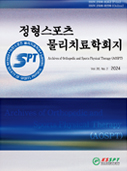Ⅰ. Introduction
Regular physical activity has been reported to enhance the physical, cognitive, and social health of adolescents (Reigal et al., 2020). However, the majority of the population still struggles to actively engage in physical activity (Haskell et al., 2007). On the other hand, physical activity not only positively impacts fitness, motor function, and health but also enhances the brain's ability to adopt a posture that can accept new information, optimizing mental conditions to improve memory and concentration (Carr & Shepherd, 2010).
Additionally, aerobic exercise increases blood flow throughout the body and brain, maintaining the normal function of the central nervous system (Kleinloog et al., 2019). It reduces the secretion of stress hormones to maintain stability in response to physical and chemical stress on the body, providing psychological and emotional stability. Moreover, it enhances adaptability to new environments or learning situations, thereby improving brain function (Thomas et al., 2012).
Balance abilities tend to decline with aging, leading to mobility issues such as walking and motor disorders (Sturnieks, St George, & Lord, 2008). Numerous studies have revealed the benefits of walking as a form of aerobic exercise to delay the aging of the body (Ergen, & Ulkar, 2007). Walking involves complex body movements that require a high degree of coordination, including kinesthetic sense, coordination, proprioceptive sensation, and the integrated action of joints and muscles. It is known to have an effect on the prevention of falls through the enhancement of balance abilities, according to studies (Vallbo, & Johansson, 1984).
With the recent surge in the popularity of barefoot walking, also known as earthing, scientific evidence regarding its effects has been emerging (Rixe, Gallo & Silvis, 2012). Walking barefoot provides direct stimulation to the muscles and connective tissues of the feet through contact with the ground, enhancing sensory function (Lee, Hwang & Kwon, 2021). It is believed to further stimulate brain function activation (Reeves et al., 2019). Additionally, practicing barefoot walking is expected to have greater effects than conventional walking due to increased blood circulation from the massage effect on the feet and enhanced stimulation of proprioceptive sensory nerves (Franklin, Li & Grey, 2018)
However, domestic studies on the direct impact of barefoot walking on balance abilities is still insufficient. Therefore, in this study, we hypothesize that there would be immediate changes in balance abilities after barefoot walking and aim to explore whether barefoot walking can bring about exercise learning effects for individuals with deficient balance abilities.
Ⅱ. Methods
1. Participants
This study was conducted with 25 healthy university students currently enrolled at Y University, with no musculoskeletal, cardiovascular, or neurological disorders. Participants were recruited through both offline and online bulletin boards on campus before the experiment. Gender ratios were not considered during recruitment based on recent preliminary study results indicating that gender does not significantly impact exercise control. Before participating in the experiment, the subjects were briefed on the purpose and methodology of the study, and all participants provided their consent to participate in the study.
2. Experimental procedure
A total of 25 participants performed 10 minutes of warm-up stretching exercise before engaging in barefoot walking, followed by the assessment of dynamic foot pressure and the Y balance test. The barefoot walking was individually conducted at a comfortable pace for 20 minutes. After the barefoot walking session, the same measurement was conducted like pre-intervention.
3. Outcome measures
1) Dynamic Foot Pressure
In this study, the Zebris FDM system was utilized to measure the pressure distribution and center of pressure displacement path during dynamic balance. Participants were instructed to walk straight and naturally across the platform equipped with the system. As participants walked, the recorded plantar pressure values were used to observe the differences in angles and support areas between the left and right feet, as well as pressure variations based on different regions of the foot support surface and the variability of the center of pressure
2) Y Balance Test
Y Balance Test is designed to evaluate lower limb strength and balance, requiring participants to move their feet along the structure in the shape of a 'Y'. Specifically, participants make an effort to extend one foot as far as possible, aiming to maintain balance during this extension. The emphasis of this process is on participants sustaining strength and balance while moving in various directions. The participants were instructed to extend their foot as far as possible to touch a line drawn on the ground from the starting point and return to the original position. This was performed three times for each leg and direction. The measured distances were averaged for each participant. Finally, the final results for each participant were calculated using the following formula.
4. Statistical analysis
The demographic characteristics of the participants were identified for normal distribution using the Shapiro-Wilk test. All results of balance abilities before and after barefoot walking intervention were compared using a paired t-test. All statistical analyses were performed using SPSS version 23.0 (USA, IBM), and a significance level of p < .05 was set.
Ⅲ. Results
This study was designed as a single-group study, comparing pre- and post-results, and the demographic data of the participants were confirmed for normality, as shown in Table 1.
Table 1
Demographics of participants
| Variables | Values |
|---|---|
|
|
|
| Sex (male/female) | 22/3 |
| Age (year) | 22.84 ± 0.85 |
| Height (cm) | 172.64 ± 4.81 |
| Weight (kg) | 71.72 ± 12.91 |
| Dominant leg length (cm) | 90.87 ± 5.73 |
1. Dynamic Foot Pressure
As shown in Table 2, the comparison of dynamic foot pressure before and after barefoot walking revealed a significant decrease in anteroposterior variability of the center of pressure (COP) (p = .023).
Table 2
Dynamic foot pressure (COP trajectory) results before and after barefoot walking
| Leg side | Composite values | P value | |
|---|---|---|---|
|
|
|||
| Pre | Post | ||
|
|
|||
| Anteroposterior variability | 8.90 ± 0.87 | 6.72 ± 0.41 | < .023* |
| Mediolateral variability | 17.25 ± 2.16 | 15.52 ±2.20 | < .082 |
*p < .05
2. Y Balance Test
As shown in Table 3, the comparison of barefoot walking before and after for the composite values of the Y balance test revealed a significant increase in performance for both the right and left feet (p < .001).
Table 3
Y balance test results before and after barefoot walking
| Leg side | Composite values | P value | |
|---|---|---|---|
|
|
|||
| Pre | Post | ||
|
|
|||
| Right | 97.89 ± 16,36 | 108.72 ± 13.42 | < .001** |
| Left | 97.33 ± 14.41 | 109.7 ± 14.54 | < .001** |
*p < .05, **p < .001
Ⅳ. Discussion
This study aimed to investigate whether aerobic exercise involving direct stimulation of the ground to the foot through barefoot walking immediately influences balance abilities. The findings revealed significant changes in dynamic plantar pressure and balance maintenance performance before and after barefoot walking exercise.
To achieve health-promoting effects through physical activity, including walking, it is generally recommended for adults to engage in moderateintensity walking for at least 150 minutes per week, in sessions of 30 minutes or more, on at least 5 days a week (Stanish, Temple & Frey, 2006). According to previous studies, those who engage in regular physical activities, including walking, are known to have a longer healthy lifespan, and walking is effective in preventing diseases such as cardiovascular disorders, diabetes, obesity etc (Omura et al., 2019).
Barefoot walking, in addition to the health benefits associated with walking, is known to directly transmit ground stimuli to the soles of the feet, further enhancing brain activation (Rickard & White, 2021). Generally, the human foot has been known to consists of 104 cutaneous mechanoreceptors that detect alterations in pressure, vibration, and skin stretch. Their distribution underscores their involvement in maintaining balance and controlling movement. These plantar mechanoreceptors reflexively contribute to orchestrating the phases of walking, sensing pressure during foot-ground contact. Moreover, in conjunction with proprioceptive afferents, they participate in the planning and correction of movement. This data is pivotal for managing both static and dynamic stability. From this perspective, the immediate changes observed in balance abilities after barefoot walking in this study may be temporary, but it can be inferred that various sensory nerve stimulations on the soles of the feet have certainly had an impact.
Furthermore, according to Nigg (2015), barefoot walking has been proposed to activate the deep muscles around the ankle, allowing for the detection of directional cues even with subtle forces. In particular, the activation of small muscles appears to be effective not only in preventing muscle atrophy due to aging but also in preventing falls in elderly individuals.
While this study did not uncover the long-term effects of barefoot walking, it verified that barefoot walking, along with the effects of regular walking, could aid in ankle muscle activation and improvement in balance through stimulation of the foot sole. In future studies, it is necessary to enhance the statistical power of the results through long-term interventions and control group.
Balance ability is also considered an indirect indicator reflecting the health status of modern individuals. For modern individuals, frequent exposure to electronic devices such as smartphones, coupled with prolonged periods of static posture, can lead to a deterioration of balance perception. Furthermore, extended use of electronic devices can contribute to issues in the neck and spine, impacting balance ability, with a lack of physical activity being a major contributing factor.
Therefore, the findings of this study suggest that barefoot walking may serve as an effective exercise guideline, as it promotes sensory function activation and enhances balance ability in a relatively short period.
The limitations of this study include the absence of a control group and an insufficient number of participants, making it challenging to generalize whether barefoot walking has superior effects compared to other forms of walking. Future studies would be necessary to incorporate a randomized control group with a larger number of participants to verify the effect size of barefoot walking.
Ⅴ. Conclusion
This study was conducted to observe the immediate effects of barefoot walking on balance abilities. The results demonstrated a significant improvement in anteroposterior variability of dynamic foot pressure and Y-balance test performance in both legs. In conclusion, considering the findings of this study and previous research, the direct stimulation of the ground and intrinsic foot muscles through barefoot walking, combined with aerobic exercise, has a significant impact on balance abilities. Further studies are needed to verify whether these immediate effects are sustained over the long term and to compare if they are superior to regular walking, preferably with control groups.













